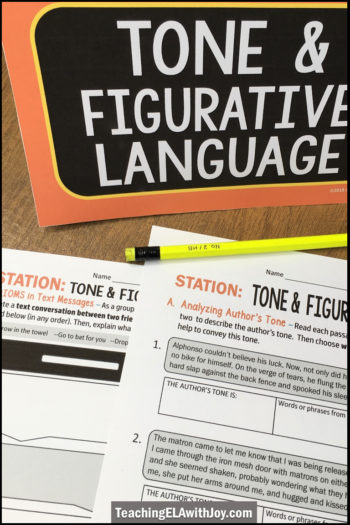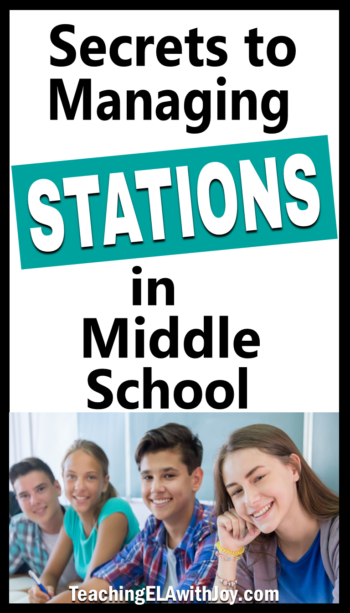
When I first considered implementing stations with my students, I was excited! I knew they would love the variety of activities and the movement. I wanted my students to practice standards-based skills through discussion and teamwork. But I was also a little worried. After all, managing station work in middle school definitely offers some challenges.
Do the Benefits of Station Work Outweigh the Challenges?
These days, teachers are expected to provide interactive learning experiences. That’s why administrators love seeing students engaged in meaningful station work when they stop by our classrooms. Movement during class is encouraged when we plan lessons. According to an article in Education Week, research now shows that when students get up out of their seats as part of their learning, blood and oxygen flow increases, which positively affects their cognitive development. Studies have also noted that working as a team helps build students’ self-esteem and leadership skills.
So why do teachers sometimes hesitate, or run into problems when they have tried station work in middle school? Though there are several factors, the biggest issue is classroom management. Picture full-sized classes of adolescents, in groups, each on a different task with different materials, each getting up to move from station to station and then re-directing themselves back into new tasks. If your students are perfect angels, and you’re expertly prepared, bravo! But what about teachers who worry about behavior, and noise level, and work completion?
I will explain an amazing “secret” that will transform the climate of your classes during station work. Let’s start with practical steps you’ll need to take that just make sense. They have to do with your own preparation and preparing your students.
Prep Work for Teachers
- Whether you’re creating stations yourself or purchasing a resource, go with station work that doesn’t require too much prep on your part. You don’t want to have to sit and cut out lots of items, laminate too many different things, etc. You’ll be exhausted before you even start. Go with something manageable.
- Make sure you have several stations that will function without technology. Technology is wonderful, but if technology breaks down, you don’t want to be left with no stations! That’s why I say try a balanced approach. If a few of the stations require technology, perfect!
- As an added “less prep” bonus when possible, create your stations so that they can be used more than once. That means more station work for your students with no extra work for you! For example, with my stations for non-fiction, I can simply choose different articles and use the stations over again. You could do this if you’re creating stations for punctuation or vocabulary. Just place different sentences or vocab words at your stations each time. With my mentor sentence stations, different mentor sentences can be substituted so that students work on writing skills at stations throughout the year.
- Have something ready for early finishers to do. I require students to bring their independent novels to class every day, so my procedure is “after you turn in the group’s responses, take out your novel and read until time is called.” Maybe you have a grammar packet or something else, but be sure you are clear on this expectation to prevent opportunities for socializing.
- After you’ve made all your copies, read over the materials for each station carefully. That way you’ll be ready to help students right away when you circulate. Then decide on the time limit you’ll give students for each station. This decision should be based on your instincts, knowing your students. Of course, you can always adjust time limits once you see how things are going.
- Formulate your student groupings. If students regularly sit in groups, change it up so students can work with new faces. I like to put some strong learners with average learners, some average learners with struggling learners, etc. Definitely mix up the ability levels, and of course, spread out the students known for behavior issues. Assign each group a number. This is important for grading purposes later. Have your group lists ready, and call them out quickly at the last minute (no time for moaning), just before students actually get up and move to their first station.
Preparing the Students
- Introduce the station work by identifying the key concepts you’ll be focusing on in the lessons. Give students an idea of how the stations will be setup, and then project an example of the station work on your whiteboard. Require your students to focus on the projected example. Point out its directions, its materials, the expectation of group discussion for all of the tasks, etc.
- Explain the time limit and the numbered order of the stations (the direction students will circulate).
- Demonstrate for students the method by which they will turn in completed work.
My Classroom Management Secrets
So now let’s get back to those potential challenges: off-task behavior, unacceptable noise levels, lack of cooperation and work completion. Plus, you’re probably wondering how you will grade all of the station work. Well, through conversations with a fellow teacher, I stumbled upon an idea that has been a game changer when it comes to these issues!
So here’s the BIGGEST secret to managing station work in middle school:
Before announcing who will be in which group, explain to students that they will be expected to all work together. They will discuss each task and complete it at the same time. No one can rush ahead or work on their own. There is a reason for this. Explain that each student’s individual work will be turned in to the group folder. However, you will randomly choose only ONE paper to grade for each station. And that grade goes in the grade book for everyone in the group. If students work together carefully, they should all be inputting similar information for their responses. So every paper should be a good one!
How does this system make a difference?
- It gives higher-level learners an incentive to look out for struggling students and help them along as they all work together.
- It limits off-task behavior because students know their paper could be the one chosen, and they don’t want to let down their peers.
- If students do begin socializing outside their groups, group members are quick to pull them back in because their grade could be affected.
Remind your students that you will be circulating. You expect to see everyone in the group working on the same question and recording their agreed-upon answers at the same time. Then, let’s say you’re walking around and see a student who is off-task or behind. You can lean in and quietly say within earshot of the group, “Let’s get focused because I might be choosing your paper for the group’s grade.” Group members will perk up and help that student back to the task.
More About Grading
An easy way to set up the grading is to get a crate of some kind with a hanging file. Label one hanging file for each class you teach (any other sectioned container will work). Then get plain manila folders and label one for each group (Group #1, Group #2, etc.). Place them within the hanging file for each class. Then physically model that when time is up, one student in the group (they decide, but it will be the same person every station) will collect all the responses. That student will bring them to the crate, and place them in the group’s file. I like to keep a box of paper clips by the crate. That way, the student can clip the group’s papers from each station together before depositing them into the folder.
Teachers, do you see the extra big bonus here? No only does this method motivate students to work together, stay on task, and monitor their own group-mates’ behavior, but you only have to grade one paper per group (per station)! That’s a score!
And guess what? You can look for strengths when choosing which paper to grade. Of course every student’s work should be represented somewhere among the different tasks you grade.
Students embrace station work and from my experience using this system, they do a really nice job. The grades are good! They bring each other up working together for that common grade. And they really do learn!
I hope that you get some encouragement from my secrets to managing station work in middle school! Students are energized moving from activity to activity. And teachers definitely love hearing all the meaningful discussions.
Click and have a look these easy-to-use ELA stations resources I created:
Literature Stations for any Novel, Drama, or Story
Non-Fiction Stations for ANY Informational Text
Mentor Sentence Stations with 120 Mentor Sentences
Source for my reference to Education Week article: Abdelbary, Marwa. “Learning in Motion: Bring Movement Back to the Classroom.” Education Week, Editorial Project in Education, 27 June 2018, www.edweek.org/tm/articles/2017/08/08/learning-in-motion-bring-movement-back-to.html.
Click here if you’d like tips for managing successful book clubs for choice reading!






Do you have pictures of how the stations look in the classroom? Also, do you have an example of the hanging file and folders?
Hi Sarah, The hanging file is just a slim box that will hold your manila folders upright so students can easily find their class folder and slip their papers in. They are available at Staples or maybe even Walmart. They come with heavy folders with a little metal hook-like edge that slips over raised vertical edges on the sides of the file box. Unfortunately, I don’t take pics in class, but you can get somewhat of an idea how a station looks if you view the cover image on one of my station resources on TeachersPayTeachers.com. (Test Prep Stations, Literature Stations, Non-fiction Stations, etc.)